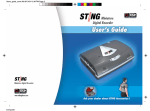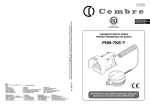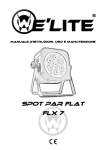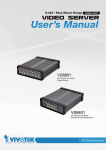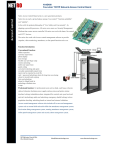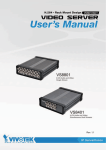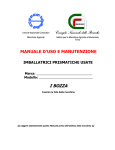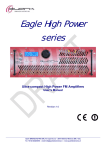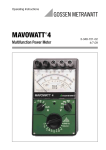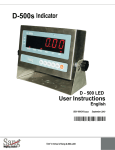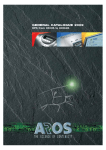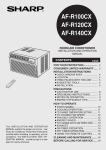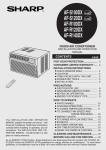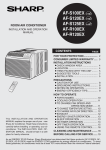Download VOLTRONIC 4 - PLC Forum info
Transcript
VOLTRONIC 4 500 / 1000 / 2000 / 4000 / 5000 VA MANUALE D’USO / USER MANUAL STABILIZZATORE ELETTRONICO DI TENSIONE MONOFASE “VOLTRONIC 4” MANUALE D’USO E MANUTENZIONE Edizione 03/03 Documento di proprietà Aros Vietate la riproduzione e la diffusione non autorizzate Indice 1. • • • • • Note generali 1.1 Dati nominali 1.2 Caratteristiche generali 1.3 Descrizione dei componenti principali 1.4 Protezioni 1.5 Segnalazioni 2. • • • • Installazione 2.1 Scelta del luogo 2.2 Alimentazione 2.3 Allacciamenti 2.4 Norme di sicurezza 3. • • • • Utilizzo 3.1 Avviamento e verifica funzionamento 3.2 Impostazione della tensione nominale 3.3 Ricerca Guasti 3.4 Assistenza 4. Schema elettrico Per scopi migliorativi l’Azienda si riserva la facoltà di modificare il prodotto descritto in questo manuale in qualsiasi momento e senza preavviso AROS EMT1046C 1/12 ITALIANO 1. Note generali 1.1 Dati nominali MODELLO - VA VOLTRONIC 4 VOLTRONIC 4 VOLTRONIC 4 VOLTRONIC 4 VOLTRONIC 4 500 1000 2000 4000 5000 Tensione nominale di ingresso 220 / 230 / 240 Vac monofase Tensione nominale di uscita 220 / 230 / 240 Vac selezionabile, monofase Frequenza della rete 48 ÷ 62 Hz Variazione accettata della tensione di ingresso Precisione di stabilizzazione Corrente di uscita @ 230 Vac Corrente max. di ingresso -18% / +14% rispetto a Vout selezionata ± 3% 2,4 A 4,5 A 9A 18A 22 A 3A 6A 12 A 24A 29 A Velocità di regolazione 2 mS x Volt Sovraccarico 1,5 IN x 5 sec. Fattore di potenza del carico Qualsiasi Distorsione armonica introdotta <0,5% Protezione contro i picchi di tensione Fino a 4 kV – 130 Joule Rendimento 98% Raffreddamento Naturale in aria Temperatura di funzionamento 0°C ÷ 40°C Umidità relativa massima 90% Grado di protezione IP 20 Indicazioni del display Allarme sonoro Ventilato Rete OK, livello del carico, sovraccarico, allarmi Attivato per sovraccarico, sovratensione, sovratemperatura Protezioni in ingresso Fusibile Magnetotermico Protezioni in uscita Fusibile Fusibile Cavo con spina Schuko Morsettiera interna Collegamento in uscita Presa Schuko Morsettiera interna Dimensioni LxPxH (mm) 180x215x194 230x350x275 Collegamento in ingresso Peso (Kg) 8,2 9,5 20,5 24.5 26 Tab.1 1.2 Caratteristiche generali Gli stabilizzatori sono progettati e costruiti secondo la Norma Tecnica EN 60950 e sono conformi ai requisiti richiesti dalle direttive europee n° 93/68/CE riguardante la marcatura CE, n° 73/23/CE relativa alla Bassa Tensione e n° 89/336/CE relativa alla Compatibilità Elettromagnetica. Lo stabilizzatore è dimensionato per funzionamento a 230 Vac secondo Normativa CEI 8-6 “Tensioni nominali dei sistemi elettrici di distribuzione pubblica a bassa tensione”. Esso è comunque progettato per funzionare con tensione nominale 220 Vac o 240 Vac. Lo stabilizzatore è destinato ad interporsi tra la rete di alimentazione ed i carichi, allo scopo di fornire ai carichi una tensione di alimentazione stabilizzata. La stabilizzazione avviene sul valore medio. Lo stabilizzatore può operare con un intervallo di variazione di carico da 0 al 100% e non è influenzato dal fattore di potenza del carico stesso; le distorsioni armoniche introdotte sulla tensione di uscita non sono apprezzabili. La presenza di un filtro RFI riduce l’effetto sul carico dei disturbi presenti in rete ed analogamente quelli del carico verso la rete. Lo stabilizzatore non fornisce isolamento galvanico fra ingresso e uscita. L’apparecchiatura è assemblata in contenitore metallico verniciato in RAL 7035 avente grado di protezione IP20. AROS EMT1046C 2/12 ITALIANO 1.3 Descrizione dei componenti principali I componenti principali sono: • Un autotrasformatore monofase “multiprese” • Un sistema di controllo a microprocessore • Un sistema di interruttori elettronici • Un sistema display • • • • L’autotrasformatore monofase multiprese dispone di 7 prese di uscita da connettere all’uscita dello stabilizzatore per poter compensare le variazioni della tensione di ingresso. Il sistema a microprocessore, monitorando la tensione di ingresso decide quale delle prese dell’autotrasformatore debba essere connessa all’uscita dello stabilizzatore per garantire la migliore regolazione della tensione al carico. Gli interruttori elettronici, comandati dal microprocessore, provvedono all’allacciamento delle prese dell’autotrasformatore con l’uscita durante il passaggio per lo zero della tensione alternata. Il sistema display, controllato dal microprocessore, consente di visualizzare, oltre al livello di carico, l’eventuale presenza di tensione di ingresso fuori dai limiti di regolazione, lo stato di sovraccarico nonché una situazione di sovratemperatura. In caso di sovraccarico, sovratensione e sovratemperatura la segnalazione è accompagnata anche da un allarme sonoro. 1.4 Protezioni Le protezioni dello stabilizzatore sono indicate nella tabella seguente: Modello Voltronic 4 - 500 Voltronic 4 - 1000 Voltronic 4 - 2000 Voltronic 4 - 4000 Voltronic 4 - 5000 Protezione in ingresso Fusibile T4A 5x20 mm Fusibile T6,3A 5x20 mm Magnetotermico 16 A Magnetotermico 25 A Magnetotermico 32 A Protezione in uscita Fusibile F5A 5x20 * Fusibile F6,3A 5x20 * Fusibile F16A 10x38 * Fusibile F25A 10x38 * Fusibile F30A 10x38 * * Sulla scheda interna 1.5 Segnalazioni Tramite il display a diodi led posto sul pannello frontale e l’allarme acustico (buzzer) sono disponibili un elevato numero di informazioni. LOAD ON ALARM Rosso Giallo Giallo Giallo Verde Legenda: • • • • • • • • • Led verde lampeggiante lentamente: tensione d’ingresso eccedente i limiti di regolazione Led verde lampeggiante velocemente: frequenza di ingresso eccedente i limiti Led verde fisso : tensione d’ingresso entro i limiti di regolazione e carico <25% Led verde + 1° led giallo: carico < 50% Led verde + 1° e 2° led giallo: carico < 75% Led verde + 1°, 2° e 3° led giallo: carico < 100% Led rosso fisso + led verde e 3 led gialli: allarme per sovraccarico Led rosso lampeggiante: allarme per sovratemperatura Led rosso fisso e tutti gli altri spenti: allarme per sovratensione di ingresso (attivo solo all’accensione). Nota: Agli allarmi visivi (led rosso ) si accompagna un allarme sonoro (buzzer) AROS EMT1046C 3/12 ITALIANO 2. Installazione 2.1 Scelta del luogo Verificare lo stato dello stabilizzatore all’atto della consegna allo scopo di accertarne l’idoneità all’uso a fronte di eventuali danni subiti nel trasporto. Posizionare l’apparecchiatura in locali la cui temperatura non ecceda i limiti di specifica, su una superficie piana e lontana da pareti e oggetti che possano ostruire le aperture di aerazione presenti sui lati e sul fondo del contenitore. Evitare la vicinanza con fonti di calore ed il contatto con materiali liquidi e/o infiammabili. 2.2 Alimentazione La rete di alimentazione deve essere monofase, con tensione nominale di 220 o 230 o 240 Vac e con una frequenza compresa tra 48 e 62 Hz. Al fine di proteggere contro corto circuiti ed in ottemperanza alle vigenti disposizioni relative alla sicurezza, l’apparecchiatura deve essere alimentata da interruttore con fusibili o interruttore automatico con corrente massima di intervento adeguata alla massima corrente di entrata (vedi Tab. 1). E’ inoltre consigliabile l’aggiunta di un interruttore differenziale. 2.3 Allacciamenti Modello Voltronic 4 – potenza 500 / 1000 VA La connessione alla rete ed alle utenze avviene rispettivamente tramite cordone di alimentazione con spina Schuko da 16 A e presa Schuko posti sul retro dell’apparecchio. Modello Voltronic 4 - potenza 2000 / 4000 / 5000 VA La connessione alla rete ed alle utenze avviene tramite morsetti interni, accessibili mediante la rimozione della parete posteriore dello stabilizzatore (fissata con 4 viti). Dopo l’allacciamento richiudere lo stabilizzatore. I collegamenti sono qui di seguito riportati: PE Terre Neutro Fase Neutro Fase Ingresso Uscita Importante: Assicurarsi deIla bontà del collegamento tra i conduttori di terra di ingresso e uscita ed il morsetto giallo/verde. Nota : Per costruzione il neutro di ingresso è collegato al neutro di uscita AROS EMT1046C 4/12 ITALIANO 2.4 Norme di sicurezza Lo stabilizzatore non deve funzionare senza il collegamento di terra. E’ consigliabile l’installazione a monte dell’apparecchiatura di un interruttore differenziale secondo le prescrizioni contenute nella Norma CEI 64-8 “Impianti elettrici utilizzatori”. E’ possibile inserire dal lato uscita ulteriori interruttori differenziali possibilmente coordinati con quello presente in ingresso. Alla luce delle caratteristiche dello stabilizzatore, l’interruttore differenziale da connettere a monte dovrà avere corrente differenziale non inferiore a 30 mA allo scopo di evitare interventi intempestivi. All’interno dell’apparecchiatura sono presenti tensioni pericolose. Eventuali interventi devono essere eseguiti unicamente da personale qualificato. In caso di necessità rivolgersi ai Centri di assistenza tecnica autorizzati. Nel caso sia necessaria la sostituzione di fusibili, essi devono essere dello stesso tipo e della stessa portata. Seguire scrupolosamente le indicazioni contenute nel presente manuale. Attenzione: questa apparecchiatura è destinata esclusivamente all’uso per il quale è stata progettata e realizzata. L’installazione deve essere eseguita seguendo le istruzioni fornite nel presente manuale. Ogni altro impiego è da considerarsi improprio e quindi pericoloso; AROS declina ogni responsabilità per eventuali danni a persone, animali o cose da imputarsi a quanto sopra citato. Conservare con cura il presente manuale per ogni ulteriore consultazione. Poiché il contenitore può essere aperto solo tramite mezzi specifici, il grado di protezione IP20 è intrinsecamente ottenuto. L’accesso ai componenti per installazione, ispezione e manutenzione deve essere consentito solo al personale qualificato e preposto a tale scopo. Prima di qualsiasi intervento, togliere alimentazione e disconnettere l’apparecchiatura. Prima di ridare alimentazione allo stabilizzatore esso deve risultare perfettamente chiuso 3. Utilizzo 3.1 Avviamento e verifica funzionamento Dare tensione all’apparecchiatura e chiudere l’interruttore posto sul retro. Verificare lo stato del display a diodi led come da paragrafo 1.5. Nel caso che il led verde lampeggi lentamente verificare che la tensione di ingresso sia entro i valori di specifica. Nel caso che il led verde lampeggi velocemente verificare che la frequenza di rete sia corretta. Se il solo led rosso è acceso permanentemente, spegnere immediatamente lo stabilizzatore e disconnetterlo dalla rete di ingresso: verificare che la stessa non ecceda il limite superiore (sovratensione di ingresso) Allacciare le utenze e verificare che non siano accesi tutti i led insieme: in tal caso il carico globale è superiore alla potenza dello stabilizzatore. Ridurre il carico a valle dello stabilizzatore. Se il led rosso lampeggia, vi è un allarme di sovratemperatura; verificare che lo stabilizzatore non sia posto in un ambiente troppo caldo e che le feritoie di aerazione non siano ostruite da polvere o oggetti esterni. 3.2 Impostazione della tensione nominale Lo stabilizzatore Voltronic 4 è impostato per tensione nominale di 230 Vac durante la fase di collaudo in fabbrica, mediante due dip-switch posti sulla scheda di controllo. Nel caso sia necessario impostare una tensione nominale differente, (220 Vac o 240 Vac) posizionare i due dip-switch, posti sulla scheda di controllo, secondo la seguente tabella : DIP-SWITCH 1 DIP-SWITCH 2 220 OFF OFF 230 ON OFF 240 OFF ON Attenzione: Per effettuare tale operazione occorre accedere all’interno del contenitore ove sono presenti tensioni pericolose. Prima di rimuovere il coperchio, assicurarsi che sia stata tolta la tensione all’ingresso dell’apparecchiatura. Al termine della regolazione, richiudere accuratamente il contenitore. L’operazione va eseguita solamente da personale specializzato (vedi 2.4) AROS EMT1046C 5/12 ITALIANO 3.3 Ricerca guasti • Mancanza accensione display - Assicurarsi della presenza della tensione di ingresso ai morsetti (per lo stabilizzatore da 2 a 5 kVA) o sulla presa di rete (per gli stabilizzatori da 0,5 e 1 kVA). Per questi ultimi verificare l’integrità del fusibile ispezionabile sul retro dello stabilizzatore. • Mancanza di tensione all’uscita - Assicurarsi del corretto allacciamento dei cavi di uscita e della bontà del collegamento stabilizzatore - carico • Mancanza di stabilizzazione - Assicurarsi che la tensione di rete sia entro i limiti di specifica Nota: in tutti i casi in cui non è possibile riscontrare la causa esatta del guasto o comunque in caso di dubbio, richiedere un intervento di assistenza. 3.4 Assistenza In caso di funzionamento irregolare, guasti o per altre esigenze, interpellare i nostri Uffici Tecnici e richiedere un intervento di assistenza. 4. Schema elettrico Schema elettrico di principio stabilizzatore – modelli 500 / 1000 VA Schema elettrico di principio stabilizzatore – modelli 2000 / 4000 / 5000 VA AROS EMT1046C 6/12 ITALIANO ELECTRONIC VOLTAGE STABILIZER SINGLE PHASE “VOLTRONIC 4” USE AND MAINTENANCE HANDBOOK 03/03 Edition This document is Aros property Any unauthorised reproduction or release is forbidden Index 1. • • • • • GeneraI information 1.1 Technical data 1.2 General description 1.3 Main parts description 1.4 Protections 1.5 Display and alarms 2. • • • • Installation 2.1 Site choice 2.2 Supply 2.3 Connections 2.4 Safety instructions 3. • • • • Use 3.1 Starting-up and operating checks 3.2 Nominal voltage setting 3.3 Fault finding 3.4 Assistance 4. Electric diagram In order to obtain better performance, the product described in the present handbook can be altered by the Company at any date and without prior notice AROS EMT1046C 7/12 ENGLISH 1.General informations 1.1 Technical data MODELS - VA VOLTRONIC 4 500 VOLTRONIC 4 1000 Nominal input voltages VOLTRONIC 4 2000 220 / 230 / 240 Vac selectable, single phase Main frequency 48 ÷ 62 Hz Acceptable variation of input voltage -18% +14% with respect to selected Vout Regulation Max. input current VOLTRONIC 4 5000 220 / 230 / 240 Vac single phase Nominal output voltages Output current @ 230 Vac VOLTRONIC 4 4000 ± 3% 2,4 A 4,5 A 9A 18 A 22 A 3A 6A 12 A 24 A 29 A Regulation speed 2 mS x Volt Overload 1,5 IN x 5 sec. Load power factor Everyone Introduced harmonic distortion <0,5% Input peak voltages protection Up to 4 kV – 130 Joule Efficiency 98% Cooling Natural Forced Operating temperature 0°C ÷ 40°C Max. relative humidity 90% Protection grade IP 20 Display indications Line OK, load level, overload, alarms Acustic alarm Active for overload, overvoltage, overtemperature Input protections Fuse Automatic switch Output protections Fuse Fuse Input connections Cable with Schuko plug Internal terminal board Output connections Schuko Outlet Internal terminal board Dimensions WxDxH (mm) 180x215x194 230x350x275 Weight (Kg) 8,2 9,5 20,5 24,5 26 Tab.1 1.2 General description The stabilizers are designed and built according to with the EN60950 Normative and are in compliance with the requirements of the European Directive n°93/68/CE concerning the CE marking, n° 73/23/CE concerning the Low Voltage Directive and n°89/336/CE concerning the Electromagnetic Campatibility. In compliance with the IEC 60038 “Standard voltages”, the rated voltage for the stabilizer is 230 Vac. Nevertheless, the equipment is designed to work with 220 Vac or 240 Vac nominal voltage. The voltage stabilizer is designed to be connected between the mains and the users, in order to supply to the loads a stabilized voltage The stabilizing effect is reached by working on the ‘mean value’. The equipment can operate with variable load from 0 to 100% and it is not influenced by the load power factor; any noticeable harmonic distortion is present on the output voltage. A RFI filter reduces the line disturbances versus the load and similarly the load disturbances versus the main. The stabilizer does not provide galvanic isolation between input and output. The equipment is housed in an IP20 metallic cubicle painted with RAL 7035 varnish. AROS EMT1046C 8/12 ENGLISH 1.3 Main parts description The main components are: • • • • An autotransformer, single phase, multiple taps A control system based on microprocessor technology An electronic switches system A display system • The autotransformer provides 7 output taps to be connected to the output to compensate the input voltage variation. The microprocessor system, by monitoring the input voltage defines which tap of the autotransformer has to be connected to the output, in order to guarantee the best voltage regulation to the load. The electronic switches, driven by the microprocessor, provide the connection of the autotransformer taps to the output during the zero crossing time of the alternate voltage. The display system, controlled by the microprocessor, provides informations on the load level, the possible presence of input voltage outside regulation limits, the overload status and the overtemperature status. In case of overload, overvoltage and overtemperature an audible alarm is also present. • • • 1.4 Protections The stabilizer protections are : Model Voltronic 4 - 500 Voltronic 4 - 1000 Voltronic 4 - 2000 Voltronic 4 - 4000 Voltronic 4 - 5000 Input protection Fuse T4A 5x20 mm Fuse T6,3A 5x20 mm Circuit breaker 16 A Circuit breaker 25 A Circuit breaker 32 A Output protection Fuse F5A 5x20 * Fuse F6,3A 5x20 * Fuse F16A 10x38 * Fuse F25A 10x38 * Fuse F30A 10x38 * * on the internal board 1.5 Display and alarms Through the led display on the front panel and the acustic alarm (buzzer) several informations are available. LOAD ALARM ON Red Yellow Yellow Yellow Green Legenda: • Green led slowly intermittent: input voltage outside regulation limits • Green led fast lighting: input frequency outside limits • Green led fixed on: input voltage within the regulation limits and load <25% • Green led + 1°yellow led fixed on: load < 50% • Green led + 1°yellow led + 2° yellow led fixed on: load < 75% • Green led + 1°yellow led + 2° yellow led +3° yellow led fixed on: load < 100% • Red led + 3 yellow leds + green led all fixed on: overload alarm • Red led intermittent: overtemperature alarm • Red led fixed on and all the other off: input overvoltage alarm (active only at switch-on) Note: to the visible alarm (red led lighting) an audible alarm (buzzer) is joined. AROS EMT1046C 9/12 ENGLISH 2. Installation 2.1 Site choice Check the stabilizer condition at the moment of delivery; in case of damages occurred during the haulage, verify that the stabilizer is suitable for a normal functioning. Install the assembly in a place where the temperature does not exceed the specification limits, on a plane surface area. lt is recommended not to close the air openings present on the lateral walls and on the bottom of the cubicle. Avoid direct heat and contact with liquid and/or inflammable materials. 2.2 Supply The main must feed a single-phase voltage to the equipment with nominal value of 220 or 230 or 240Vac at a frequency within 48 ÷ 62 Hz range. In order to protect against short-circuit or overload and in compliance with the in force safety regulations, the stabilizer must be fed through either a circuit breaker with fuses or a circuit breaker with automatic release. The maximum activation current must depend on the highest input current (see table 1). In addition, it is advisable to add a co-ordinated differential switch 2.3 Connections Model Voltronic 4 - 500 / 1000 VA The connection to the main and to the load is made respectively by mean of the supply cord with 16 A Schuko plug and the socket Schuko on the rear of the product. Model Voltronic 4 - 2000 / 4000 / 5000 VA Make the connection to the mains and to the users by means of the terminal boards reachable by removing the rear wall of the stabilizer (fixed by means of 4 screws). After the connections, reinstall carefully the rear panel. The connections are: PE Grounds Neutral Phase Neutral Phase Input Output Important: Be sure of the good connection between input and output wires and the yellow/green connecting terminal. Note: For design reason the neutral of the input and output are internally connected. AROS EMT1046C 10/12 ENGLISH 2.4 Safety instructions The stabilizer must not function without the earth connection. It is recommended to put a circuit breaker with differential current release on the stabilizer input line in compliance with the IEC 60364 “Electrical installations of buildings”. Further circuit breakers with differential current release can be put an the output line and co-ordinated with the one an the input line. On the basis of the stabilizer characteristics, the circuit breaker with differential current release on the input line should have a differential current not !ess than 30 mA in order to avoid unnecessary activation. Inside the equipment there are dangerous voltages. Any maintenance operation must be carried out only by qualified personell. If necessary, please contact an authorised ‘Technical Service Centre’. If a fuse needs to be replaced, use new one of same type and rating. Follow carefully the instructions given in the present handbook. Warning: the stabilizer must be used exclusively for the purpose for which it has been designed and built. Installation must be done accordingly to the instructions provided with the present handbook. Any other utilisation has to be consìdered as inappropriate and therefore dangerous; AROS will not to be held liable for possible damages to people, animals and belongings due to fall of the above. Preserve with care this handbook for further use. The enclosure containing the stabilizer cannot be opened without speciflc means. Therefore, both the protection against direct contact and the campliance with the IP20 protection are inherently obtained. Access to the components for installation, setting, inspection and maintenance must be granted only to qualified personnel in charge of it. Before starting any operation, disconnect the stabilizer from the main. Before to supply the stabilizer, it must be perfectly closed. 3. Use 3.1 Starting-up and operating cheks Supply the stabilizer and close the switch on the rear. Verify the display status as per para 1.5 In case that the green led is lighting slowly check that the input voltage value is within the limits. If the green led is fast lighting, check that the main frequency is correct. If the red led is permanently on, switch-off immediately the stabilizer and disconnect it from the main; verify that the main voltage does not exceed the upper limit (Input overvoltage). Connect the loads an verify that all the leds are not on together: in this case the load is greater than the stabilizer power. Reduce the load. If the red led is intermittently lighting, there is an overtemperature alarm; verify that the stabilizer is not in a too warm ambient and that the ventilation openings are not closed by dust or external objects. 3.2 Nominal voltage setting The AROS stabilizer is set for 230 Vac nominal voltage, during test phase in production, by means of 2 dip-switches on the control board. In case it is necessary set a different nominal voltage (220 Vac or 240 Vac), move the dip-switches, placed on the electronic card in accordance with the following table. DIP-SWITCH 1 DIP-SWITCH 2 220 OFF OFF 230 ON OFF 240 OFF ON Warning: In order to make the adjustement, it is necessary to operate internally to the box where dangerous voltages are present. Before remove the cover, be sure that the voltage at the input of the stabilizer is not present. Made the adjustment, close carefully the box. The operation must be carried out only by qualified personell (see 2.4) AROS EMT1046C 11/12 ENGLISH 3.3 Fault finding • The display does not light - Check the presence of the main voltage on the connecting terminals (for 2 to 5 kVA models) or on the main plug (for 0,5 and 1 kVA models) • No output voltage - Be sure of the correct connection of input and output cable and of the good quality of connection stabilizer – load • No stabilization - Be sure that the input voltage variation is within the limits. Note: In case the exact fault cannot be detected or for any doubt, make request for authorized assistance. 3.4 Assistance In the unlikely event of malfunctions or faults, please contact our Technical Department and ask for assistance. 4. Electrical diagram Stabilizer electric block diagram – models 500 / 1000 VA Stabilizer electric block diagram – models 2000 / 4000 / 5000 VA AROS EMT1046C 12/12 ENGLISH Via Somalia, 20 20032 CORMANO (MI) ITALY e.mail: service@aros.it n° verde: Tel: Fax: +39 800 48 48 4 +39 02 66 32 71 +39 02 61 52 04 9














